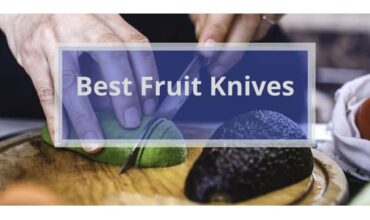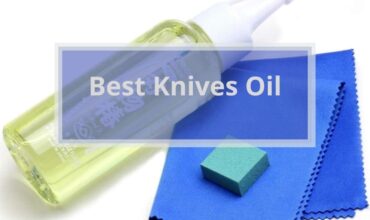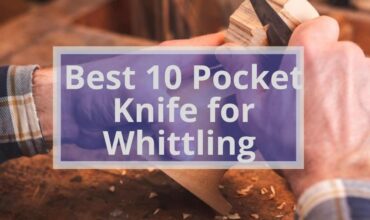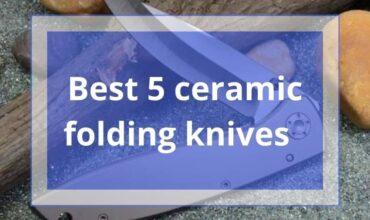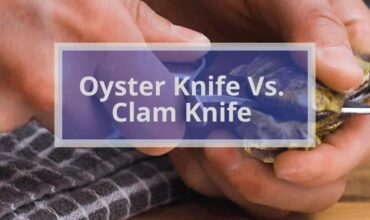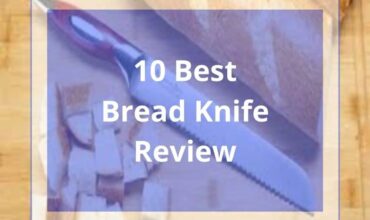What is a Forged knife?
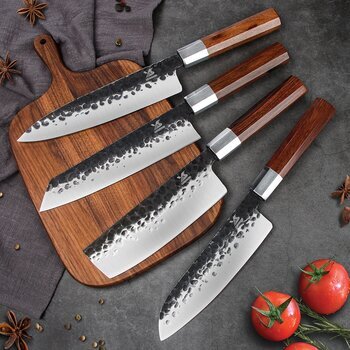
Definition
Forged knives are made of a high-carbon single piece of steel. That has been shaped into a kitchen knife shape. This hard process requires an expert and skilled knifemaker.
Many new kitchen knife makers do handcraft their forged kitchen knife sets. but due to the strong demand for high-quality knives with forged blades. Large factories had to expand their output. By incorporating more advanced systems with manual supervision.
The forging method is massive, labor exhausting, and needs both technology expertise.
To make things more clear, the well-known Wusthof knife brand goes through 40 steps procedure. With a couple of superiority checkups to produce their forged bar of steel blades.
While for the Zwilling knife JA Henckels stamped kitchen knife product lines only go through 14 steps procedures.
The forging procedure includes heat tempering at a temperature of 2000°F at least, which produces more flexible forged steel ready to be shaped.
Actually, forging knives used to be done by hand. But now the modern machinery and mechanical assistance are used in the entire forging. And the carbon steel heat tempering processes.
On the other side, several knife makers still use the hot drop-forging technique. That depends on manufacturers’ hands to turn the hot-forged piece of metal into the kitchen knife.
Whatever the hammer forging technique is used, (whether traditional or modern forging). The forged cutlery produced is much more robust and long-lasting than any stamped knife.
They have excellent knife blade edge retention.
The only drawback is that forged kitchen knives are so expensive.
Read more, Best Fruit Knives Review
Which Brands Are Forged?
What is a Stamped Knife?
A stamped kitchen knife is cut from a huge sheet of steel rather than a specific piece of high-carbon stainless steel. The laser cutting of the blade is identical to cutting the big dough with a bread slicer.
What is the benefit of this cutting process? It allows rapid cutting of several blades at a lower production rate. That is the reason why a stamped knife is less expensive than a forged knife.
What sets any stamped kitchen knife apart is its thin blade that is adaptable.
Which Brands Are Stamped?
Manufacturing Differences Between Forged and Stamped Knives
Stamped knives
- A computer is programmed with the form of the kitchen knife shape.
- Massive stainless steel sheets are placed under the laser cutter.
- The stamped type of knife is carved from a sheet of metal.
- Tempering is applied to the blades.
- They get honed for enhanced longevity and efficiency.
- Then the blades get shaped and fixed to the handles.
Forged knives
- For the knife mold, computer-aided modeling is used.
- Steel bars are pre-cut and heated to exceptionally high temperatures.
- Red hot steel is formed to the desired shape.
- For setting the strength of the steel blades, they get tempered.
- For producing a razor-sharp edge knife. it must be hammer forged
- Then comes the cleaning and polishing processes.
- After that comes the knife handle connection. Bolster and tang finishing.
- Final examination of the product lines and sharpening to a pre-determined angle.
What Are The Key Differences Between Forged and Stamped Knives?
Forged knives are made of a single bar of steel that is heated and pounded into shape by a trained craftsman or a machine. While stamped knives are cut out from a large sheet of steel. and then honed and heat-treated for extra durability
Now, let’s go through the key differences between both types in detail.
Blade construction
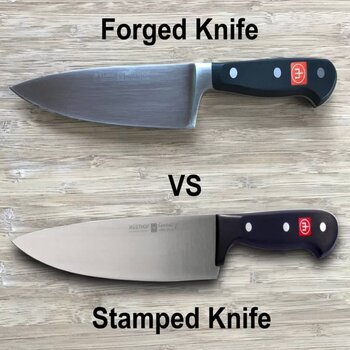
Forged knives have thicker blades than stamped knives as they are cut from a single block of high carbon steel. While stamped blades are manually carved from a huge thin sheet of stainless steel.
Forged blade knives comes in various thicknesses, running from the knife edge that becomes slimmer until it reaches the endcap.
The knife’s densest section is between the handle endcap and the safety bolster.
That differs from the stamped knife blade thickness, which is continuous from the edge of the blade to the endcap of the handle.
You need to know that the thickness of the forged blade increases its longevity and accuracy. And provide a more flexible and well-balanced blade while cutting
Read more , How to Sharpen your Knives Without a Sharpener?
Safety bolster

The steel part that attaches the blade to the handle is known as a bolster. It serves as a safety barrier, reducing the possibility of your hands sliding over the edge.
Not only this, but it also adds toughness to the knife and makes it heavier and more dependable.
Safety bolster is categorized as follows:
- Full bolster
- Half bolster
- Partial bolster
Wusthof classic ikon creme collection of knives and Japanese knife sets are always designed with full bolsters. That’s why you will find them thick, large, and secure.
But that makes sharpening the whole blade edge difficult, as the steel at the endcap of the handle is so thick,
On the other side, the blades that have half or partial-safety bolsters are shorter and do not have the same level of protection. But they offer an easy knife sharpening process.
A stamped knife set has the same thickness all the way through, so, they do not have a bolster.
Tang
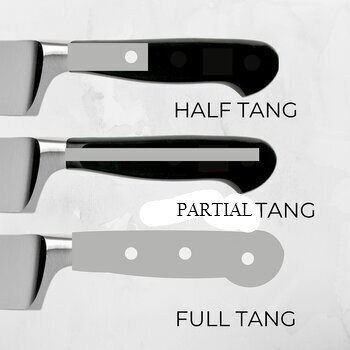
A fully tanged knife handle may be crafted on either stamped or forged knives. However, stamped knives do not usually have one.
The tang is the steel segment that runs through the knife handle until it reaches the endcap.
A full tang ensures that the stainless steel blade extends into the knife handle. While a half or partial tang means that the stainless steel stops in the center of the knife handle. And is protected with steel rivets.
Actually, the greater the tang is, the more robust and stable the knife becomes. Why? because the tang is what holds the blade connected to the handle for added protection.
All forged blades are crafted with a full tang, while stamped knives are designed with a half tang.
Tangs have the disadvantage of adding weight to the knife. And becoming loose during repeated use. That is why some seasoned chefs choose stamped knives over forged knives.
Also check , What Are The Different Types of Kitchen knives and Their Uses?
Weight
Many aspects affect the additional weight of a forged blade knife, including the thickness of the blade, the material or tang of the handle, and the type of protective bolster.
Stamped knives have lighter weight since they are not equipped with a safety bolster and a half-tanged handle. And at the same time, they are carved from a sheet of stainless steel.
A heavyweight, hard, sharp edge cook’s knife or serrated knife is the ideal choice while chopping hard fruits. Such as pineapple. While a thin blade like a paring knife is better when preparing more fragile foods, such as onions.
Flexibility
In terms of adaptability and versatility, forged knives are stiffer and more controllable. As a result, they are ideal for slicing harder foods like carrots, breaking big pieces of beef, and mincing garlic or herbs.
They are easy to be sharpened and hones with any knife sharpener and honing steel, as whetstones, or electric knife sharpeners.
When it comes to stamped blades, they are adaptable and make easier maneuverings when cooking delicate ingredients. making them a safer choice to make.
Sharpness
Sharp edges are achievable for both forged and stamped blades.
Note that the tinier the angle is, the more defined the blade’s entire edge becomes. the edge angle ranges between 10 and 20 degrees on either side, the recommended range is 16 degrees.
The most refined edge is perfect for chopping fragile foods. But be cautious since they are more prone to chipping or breaking.
It is worth mentioning that the most durable and dependable knives are sharpened at a 15-degree angle.
Because of the big, wedged blade construction. Forged knives are designed to endure the heavy-duty cuts of chopping. utilizing the rocking style motion.
On the other hand, the thin blade of lower-cost stamped knives is the best option for performing light tasks or precise cuts. like a carving knife
Edge retention
The significant distinction between forged and stamped knives is edge retention.
Knives that are often forged keep their edge retention much longer than stamped knives. Causing more frequent knife sharpening.
This is because forged blades are made using a tempering process. that produces strong blades that can keep their edge for longer than stamped blades.
Ease of Sharpening
Manual knife sharpening is better with forged knives. while electrical knife sharpeners are suitable for both types.
Price
Because of the complicated production processes used to produce them. Forged knives are more costly than stamped knives. They are more robust and heavier, as they use expensive alloy steel and raw materials
In fact, the price is influenced by the product brand names, the kind of steel used, and the location.
Are stamped knives good?
Yes! they are good! There is a widespread misunderstanding that a stamped knife is not a high-quality knife.
Stamped knives, from famous brands like Global, Henckel, Wusthof (Gourmet collection), and Misen come in high quality with excellent performance.
So we can’t say that forged knives are better than stamped knives or vise versa. as it depends on you and your preferences.






